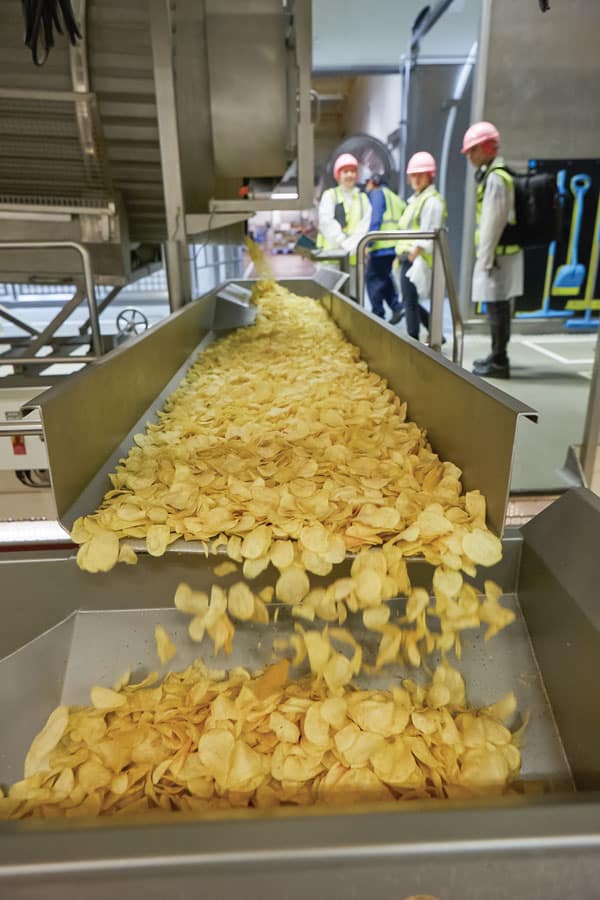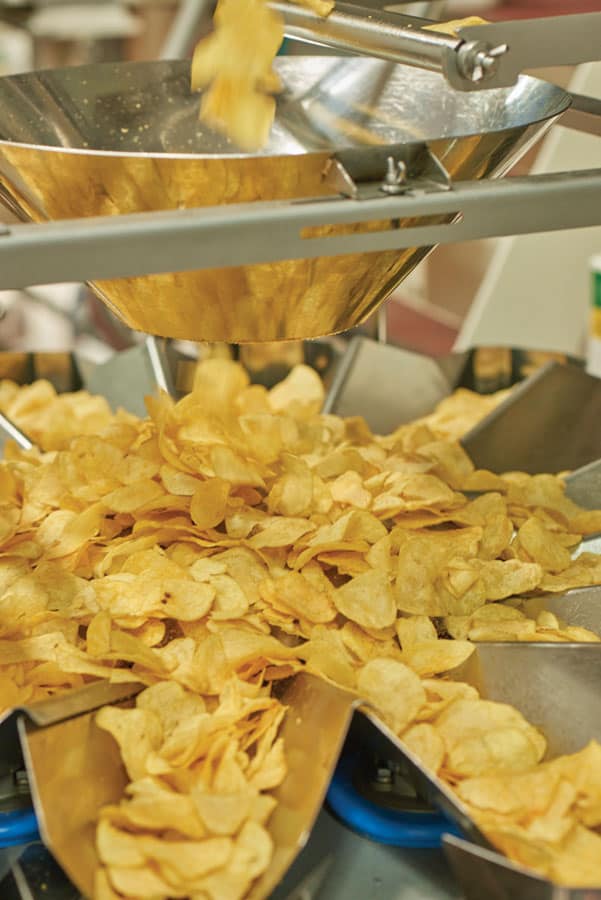Louise Mayor tours to the world’s biggest crisp factory to find out how physicists are fine-tuning the transformation of potatoes into our favourite salty snack
As I walk into the giant Walkers crisp factory on the outskirts of Leicester, UK, the first thing that strikes me is the noise. I hastily insert my bright-pink ear plugs – part of a compulsory outfit that includes a blue over-suit, a hair net and non-slip steel-toe-capped shoes. It’s warm, steamy and smells – as you might expect – like a chip shop. Tall stainless-steel structures, all jiggling or vibrating, fill the brightly lit cavernous space, the size of a football pitch.
I’m being given a tour of the biggest crisp factory in the world, which every day receives 675 tonnes of potatoes that it turns into five million packets of crisps. My guide is John Bows, a physicist at the multinational snack giant PepsiCo, who researches new processes to improve the production of the humble potato chip. Crisps are a multi-billion-dollar industry worldwide, so the firm – which owns brands such as Cheetos, Doritos, Lays and Walkers – invests in physicists to help get that competitive edge. Even an incremental improvement in production pays off in no time.
I don’t have the faintest idea how physics can be used to improve what is basically frying slices of potato in oil. But Bows’ enthusiasm is infectious and so I’m here with an open mind. I’m intrigued to find out what physics is involved as we make our way around the factory, right from the incoming-potatoes stage to the final packaged product.
Peeled and sliced
We begin at “raw materials – receiving”, where a lorry reverses in, tips its container and pours out a torrent of potatoes. A powerful hose helps them roll and float out into an open flume where they drift away, like some kind of potato water park. No-one wants anything other than potatoes accidentally entering the plant so any floating debris is skimmed off by a “de-wooder”, which is followed swiftly by a “de-stoner”. “Anything heavier, or more dense, than a potato will fall more readily and therefore will go through this tube,” says the on-duty technician, who pulls a lever to reveal what gets sieved out. A load of stones clatter down and I’m surprised to see a few small potatoes too. As Bows explains, the few millimetres near the surface of a potato are more dense than the rest, which means that small potatoes are slightly denser overall than large ones so get discarded here.

Walkers used to get phone calls years ago from customers complaining about solid non-potato chunks in their crisp packets. The problem was that golf balls would occasionally arrive along with the potatoes, and as these little white spheres happen to have the same density as potatoes, they didn’t get removed with the density-based sorting system. I wondered if this lumpy problem was solved by some clever change in the manufacturing process in the factory, but Bows reveals a much simpler solution: Walkers now only sources potatoes from farms that are well away from golf courses.
Walking to our next port of call I am surprised by the amount of liquid on the floor, as well as the odd mound of foam, and little piles of stray potatoes nestled into the corners of steel platforms. Holding onto a rail, I climb up some steel steps to the next processing stage, where the raw potatoes are peeled in giant metal chambers. Although I can’t see in – the chambers are sealed off – they are making a racket. As Bows explains, a batch of potatoes is being dropped in and spun around in an abrasive circumference for two or three minutes, which removes 90–95% of the peel. “How much is actually removed depends on the potato’s shape – if it’s absolutely spherical we get a good peel removal, but there’s always some left on,” he says. That might sound a bit shoddy, but consumers apparently don’t mind a bit of dark peel around the edges of a crisp. If anything, it makes them perceive the product as being more “natural”.
Talking of colour, Bows says probably the worst thing for consumers is to find a green crisp in their packet. To avoid that scenario, PepsiCo has installed a computerized vision-inspection system, which images each and every peeled potato and discards any that aren’t the right colour. “If you reject here – whole potatoes – it’s more efficient than rejecting green crisps later down the line,” Bows explains. Two lines of cameras face the oncoming stream of potatoes and an array of black rectangular “fingers” flicks any rejects down below. The action is so fast that it’s a challenge to see the fingers move, but we do hear the occasional “dunk!”, followed by the sound of a potato rolling away and falling into a vat below.

Our next stop is the slicing station, where a technician bends over a squat metal cylinder (without its ends on), roughly 40 cm wide, with the curved edge vertical. Every 90 minutes or less a technician checks – and if necessary replaces – each of eight blades spaced around each cylinder. Blunt blades are a no-no as they cause excess ripping of cells at the potato surface. Beside us, several other slicers are in use. Potatoes drop down into the cylinder, which has a platform at the base spinning at about 200 rpm; this throws the potatoes sideways into the blades, where they get sliced in one go. “There’s actually a tremendous amount of physics going on in here,” says Bows. Since the potato gets cut in a curved profile, the inner and outer surfaces of the slice experience different shear forces. This causes the outer surface to be more fractured and to release more starch.
I can certainly see that going on – the slices are carried away in a flume, this time in an opaque milky-coloured liquid. Bows assures me that all the starch gets recovered at the on-site starch-recovery plant – waste of any resource, including energy and water too, is kept to a minimum. Bows and his team are currently working on how to redesign the slicers to reduce starch loss in the first place. “If you can go from 2% starch loss to 1% starch loss, that’s a big saving in the solids, which translates to heavier chips,” he explains.
Hotting up
Next we go to the warmest part of the production line: the fryer, where the cut potatoes are cooked in hot oil. The frying is hidden from view, taking place in a covered metal chamber several metres long. But Bows first draws my attention to the step just before, where the flume carrying the sliced potatoes turns a corner and fans out into a fishtail shape, depositing the slices onto a conveyor belt about two metres wide. His group is researching how to ensure that the transfer of slices from the flume to the conveyor belt results in the overlapping slices having a uniform mass distribution.
“If you were to watch for a long time, you would see that this isn’t really uniform ‘left-centre-right’ mass distribution,” Bows explains. “And if it’s not uniform here, it’s not uniform going into the fryer.” Higher-density areas of slices within the flyer can lead to soft crisps, where not enough water can escape and the slices don’t reach the optimum temperature. The researchers working on this project have to understand the physics of slices in turbulent liquid so that their models are accurate and can be used to improve the flume and fishtail designs.
After the fishtail, the slices might have 10–15% surface water, the precise amount of which is one of the biggest throughput limitations of the fryer. Another research project at PepsiCo is to understand the surface physics of removing water from a potato slice, and how best to extract it. One method is to fire jets of air at the slices, and vacuum the resulting water droplets away before they can resettle. The team is aiming for a reduction to 8% surface water, pre-fryer.
“There’s a delta-T across the fryer,” Bows says, slipping into language that marks him out as a physicist. “This is one of the control parameters of the texture.” For an ordinary crisp, which is about 10 potato cells wide, temperature is set to about 180 °C at the entrance to the fryer and 160 °C at the exit. The slices are moved through various frying zones using rotating paddles, which serve both to break up clumps, and to submerge buoyant slices that have floated to the top of the oil. As the slices move through the fryer, the starch within them undergoes several phase transitions. The starch passes from its native crystalline state through to a rubbery “melt phase”, and then through glass transition and back to a glassy phase. “If you get the timing of that process right, and if you get the right temperature curve, you get the right texture,” says Bows. “The starch conversion is critical.”

To use a continuous fryer – like the ones at Walkers – to make thick, brown and crunchy gourmet-style “kettle chips”, you can simulate the original batch method of kettle-chip manufacture, in which a whole load of potato slices are dunked into a vat or “kettle” of oil, causing the temperature to lower before rising back up again. By changing the time–temperature profile along a continuous fryer so that it starts off hot, cools a little and then gets hot again, the starch is converted at a different rate to give a harder, crunchier bite, matching crisps made using a batch fryer.
As the slices exit the fryer, they still have a high internal vapour pressure, which continues to drive off water vapour. It is only once the internal vapour pressure collapses that oil is sucked into the slices. After this stage, crisps are typically about 30% oil. Walkers crisps use high oleic sunflower oil, which is low in saturated fat.
We now move on to Bows’ favourite device in the Leicester plant: the “Optisort”. This machine is similar to the vision-inspection system that discards whole green spuds, but whereas that machine imaged every individual potato, the Optisort images every single crisp. Considering that there are typically 20–30 slices per potato, the Optisort has to work a lot faster. So before they pass through the device, the crisps are arranged on the conveyor belt in a layer one crisp thick so that every crisp is visible, then sped up by making them fall down a parabolic curve. “The curve’s been designed to accelerate the potato slices, so they fall through at incredible speed,” says Bows. Moving at 3 m/s – about a third of the speed of an Olympic sprinter – I’m mesmerized by the sight of the “singulated” crisps whizzing past. Arrays of cameras photograph every single slice to check they are a nice golden-yellow colour, with green or black slices rejected. The movement is so fast that at first I can’t figure out how the rejects are removed from the stream. Bows then points out a gap about 10 cm wide which the crisps fly over horizontally. Any duds are dispatched downwards with a swift puff of air.
Flavour of the month
So now we have it: the unseasoned PepsiCo crisp. Up until this point I have seen what is a standard process in PepsiCo crisp factories throughout the world, where all that differs is the potato variety. What comes next is for these Walkers crisps to be tailored to the British market. Through a set of double doors, we leave the realm of noisy automated machinery, where we met just two people, and enter a quieter space filled with staff. Noisy vibrations are replaced with the light chatter of factory workers as a power ballad – “Unchained melody” – plays on the radio in the background.
The crisps’ journey continues as they are sent tumbling through giant rotating drums, where a curtain of seasoning powder drops onto them. Bows says that his team looks at physical parameters such as the Froude number – the ratio of inertial to gravitational forces – to optimize the drums so that breakage is minimized but coverage time is maximized. I can smell the seasoning but neither Bows nor I can quite identify it. Wandering around the drum we find several labelled cardboard boxes that solve the mystery: it’s good old cheese and onion, which Bows and I agree is our favourite flavour. We also concur on the worst: prawn cocktail.
My tour’s still not quite over. I walk up some steps to an elevated platform and am faced with a myriad of circular devices all making a rhythmic clunking noise. It is here that the crisps are weighed and bagged, using a method like nothing I had imagined. At each station, crisps fall from above, onto a metal plate shaped like a 14-petalled flower. Each “petal” funnels crisps into one of 14 hinged buckets or “heads” that are arranged in a circle below. Once every second or more, a couple of these heads – different ones each time – tip their contents into a central vertical shoot that disappears to a lower level. “These heads will take in about four or five crisps at a time, and some combination will be very close to the target weight and dispensed to the bag-maker underneath,” explains Bows. “It’s a purely statistical process.”
Below deck I see indeed that each dumped load corresponds to a bag being filled and sealed. The crisps drop into a tube of packaging material inflated by nitrogen, which feeds downwards at a rate of about a metre every 4 seconds. A heat-sealer and slicer lops off each filled packet at a rate of about 1.6 per second. The packets then fall onto a conveyor belt and go onwards and upwards to be further packaged by robots into multipacks or boxes, and on to the consumer. Another current research project, Bows tells me, is to look into how to reduce the seal from its current width of about 3 mm to 1 mm. “This would save a fortune in packaging material,” he says. Considering the volumes involved at the Leicester factory, those little enhancements would soon add up.
After leaving the factory, as we’re peeling off our hair nets, I have one last question. I’d already committed a faux pas by claiming that my favourite crisp is a cheesy puff – an affronted Bows had reminded me that cheesy puffs aren’t crisps, which by definition are slices of potato fried in oil. But I’m curious to know what happens to that starchy liquid we saw sloshing around at the slicing station. “That starch you recover on site – where does it go?” I ask. “Oh, the starch?” replies Bows. “We make Quavers out of it.” No-one can accuse PepsiCo of letting anything go to waste.
- See below for a video interview with John Bows about his career




